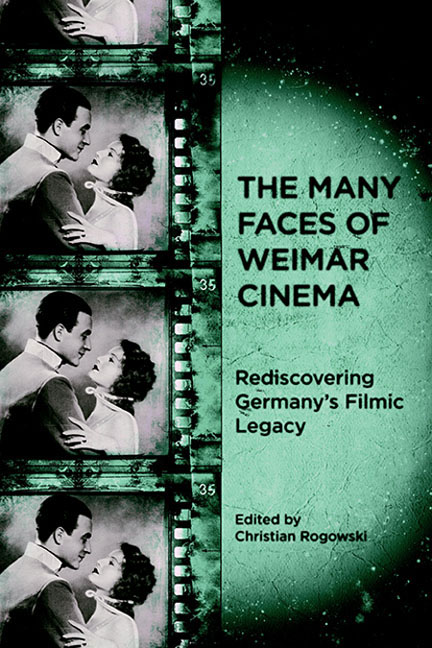Book contents
- Frontmatter
- Contents
- List of Illustrations
- Preface
- Introduction: Images and Imaginaries
- 1 Richard Oswald and the Social Hygiene Film: Promoting Public Health or Promiscuity?
- 2 Unsettling Nerves: Investigating War Trauma in Robert Reinert's Nerven (1919)
- 3 Humanity Unleashed: Anti-Bolshevism as Popular Culture in Early Weimar Cinema
- 4 Desire versus Despotism: The Politics of Sumurun (1920), Ernst Lubitsch's “Oriental” Fantasy
- 5 Romeo with Sidelocks: Jewish-Gentile Romance in E. A. Dupont's Das alte Gesetz (1923) and Other Early Weimar Assimilation Films
- 6 “These Hands Are Not My Hands”: War Trauma and Masculinity in Crisis in Robert Wiene's Orlacs Hände (1924)
- 7 The Star System in Weimar Cinema
- 8 Schaulust: Sexuality and Trauma in Conrad Veidt's Masculine Masquerades
- 9 The Musical Promise of Abstract Film
- 10 The International Project of National(ist) Film: Franz Osten in India
- 11 The Body in Time: Wilhelm Prager's Wege zu Kraft und Schönheit (1925)
- 12 Henrik Galeen's Alraune (1927): The Vamp and The Root of Horror
- 13 The Dialectic of (Sexual) Enlightenment: Wilhelm Dieterle's Geschlecht in Fesseln (1928)
- 14 Babel's Business — On Ufa's Multiple Language Film Versions, 1929–1933
- 15 “A New Era of Peace and Understanding”: The Integration of Sound Film into German Popular Cinema, 1929–1932
- 16 Landscapes of Death: Space and the Mobilization Genre in G. W. Pabst's Westfront 1918 (1930)
- 17 Undermining Babel: Victor Trivas's Niemandsland (1931)
- 18 Unmasking Brigitte Helm and Marlene Dietrich: The Vamp in German Romantic Comedies (1930–33)
- Filmography
- Notes on the Contributors
- Index
9 - The Musical Promise of Abstract Film
Published online by Cambridge University Press: 29 April 2017
- Frontmatter
- Contents
- List of Illustrations
- Preface
- Introduction: Images and Imaginaries
- 1 Richard Oswald and the Social Hygiene Film: Promoting Public Health or Promiscuity?
- 2 Unsettling Nerves: Investigating War Trauma in Robert Reinert's Nerven (1919)
- 3 Humanity Unleashed: Anti-Bolshevism as Popular Culture in Early Weimar Cinema
- 4 Desire versus Despotism: The Politics of Sumurun (1920), Ernst Lubitsch's “Oriental” Fantasy
- 5 Romeo with Sidelocks: Jewish-Gentile Romance in E. A. Dupont's Das alte Gesetz (1923) and Other Early Weimar Assimilation Films
- 6 “These Hands Are Not My Hands”: War Trauma and Masculinity in Crisis in Robert Wiene's Orlacs Hände (1924)
- 7 The Star System in Weimar Cinema
- 8 Schaulust: Sexuality and Trauma in Conrad Veidt's Masculine Masquerades
- 9 The Musical Promise of Abstract Film
- 10 The International Project of National(ist) Film: Franz Osten in India
- 11 The Body in Time: Wilhelm Prager's Wege zu Kraft und Schönheit (1925)
- 12 Henrik Galeen's Alraune (1927): The Vamp and The Root of Horror
- 13 The Dialectic of (Sexual) Enlightenment: Wilhelm Dieterle's Geschlecht in Fesseln (1928)
- 14 Babel's Business — On Ufa's Multiple Language Film Versions, 1929–1933
- 15 “A New Era of Peace and Understanding”: The Integration of Sound Film into German Popular Cinema, 1929–1932
- 16 Landscapes of Death: Space and the Mobilization Genre in G. W. Pabst's Westfront 1918 (1930)
- 17 Undermining Babel: Victor Trivas's Niemandsland (1931)
- 18 Unmasking Brigitte Helm and Marlene Dietrich: The Vamp in German Romantic Comedies (1930–33)
- Filmography
- Notes on the Contributors
- Index
Summary
In his 1916 presentation, “Die künstlerischen Möglichkeiten des Films” (The Artistic Possibilities of Film), the already renowned actor and filmmaker Paul Wegener lamented that films up to that point were largely a disappointment. In its first twenty years, the medium had produced mostly kitsch — poor imitations of bad theater with stories reminiscent of trashy novels. This assessment notwithstanding, Wegener insists: “Das Ding ist gut!” (the thing is good). He declared that film would one day become more than simply a lesser theater for the hoi polloi, and that even his own widely admired artistic achievements — starring in Der Student von Prag (The Student of Prague, 1913) and directing Der Golem (The Golem, 1914) — did not begin to approach the level of filmic artistry that was coming. One day, the medium of film would move beyond the plebeian and produce works that would deliver “an artistic experience … an optical vision, a great symphonic fantasy” (Wegener). But in 1916 the artistic possibilities of film had yet to be realized. To do so, according to Wegener, would entail liberating film from the yoke of narrative and cultivating its essence, which, as his “symphonic” vocabulary betrays, is akin not so much to stage or novel as to music.
Though Wegener himself did not take up the challenge suggested by this vision of film's future, a few short years later a handful of artists would set about making what has been termed optische Musik (optical or visual music). Ascribing musical qualities to film was already widespread by the early 1920s, with cinema frequently referred to as “the music of light” (King, 35), but the musical quality of these particular films was different; it was more pronounced, more distinctly “musical.” Even in the heady atmosphere of experimentation that surrounded film production in early Weimar Germany, Walther Ruttmann's Lichtspiel Opus 1 (Film Opus 1), Hans Richter's Rhythmus 21 (Rhythm 21), and Viking Eggeling's Symphonie diagonale (Diagonal Symphony) were avant-garde. Sometimes referred to as a kind of “absolute film,” they refrain from narrative elements or even figurative representation. Instead, these one-act films (ranging typically from three to twelve minutes in length) offer animated geometric patterns, in many ways not entirely unlike today's screensavers.
- Type
- Chapter
- Information
- The Many Faces of Weimar CinemaRediscovering Germany's Filmic Legacy, pp. 153 - 166Publisher: Boydell & BrewerPrint publication year: 2010

